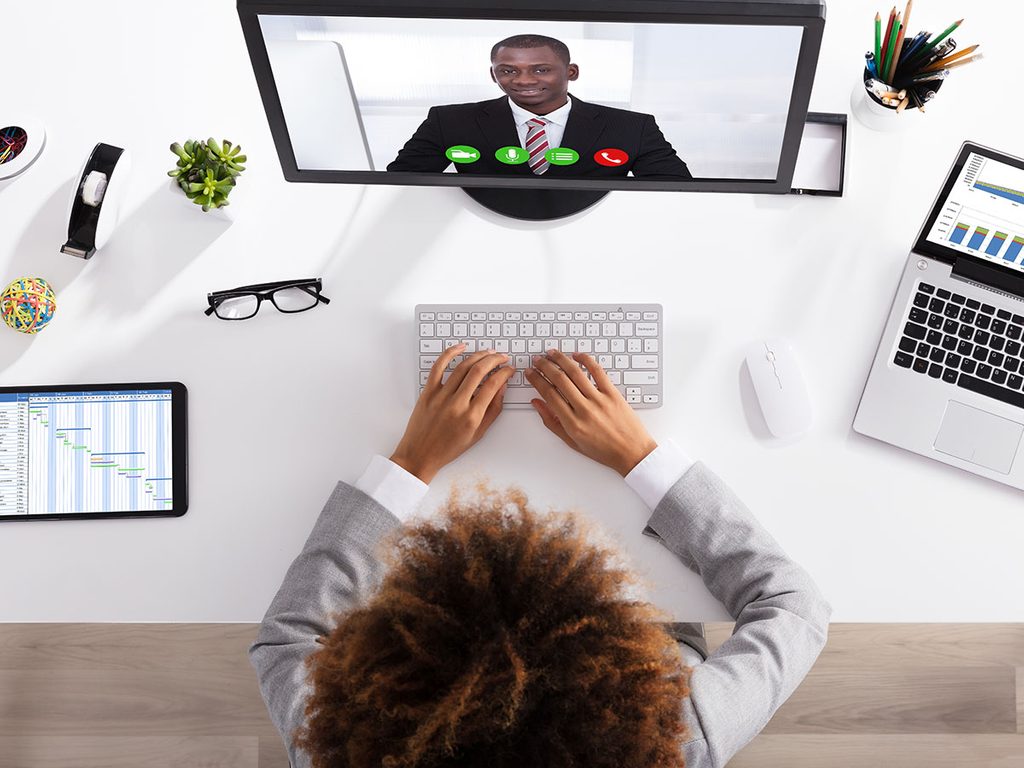Work-from-Home Rules Everyone Needs to Follow

An etiquette expert shares tips for being as professional as possible.
While working from home in quarantine, we’re doing things we never thought we’d do. We take client calls in closets, live in chaos while our Zoom backgrounds suggest a Stepford-type situation, and try to sound authoritative during meetings while wearing quirky pajama pants, the same pair we’ve been in since quarantine began. We’re adopting as best as we can to this new life, where relationships with colleagues are sustained primarily over email, and you’re judged by your presence and opinions you share during the handful of virtual meetings each month. So, it could be time for a check-in: Is it possible we’ve gotten a little too comfortable at home and lost a bit of our professionalism?
We spoke with Lisa Orr, a certified etiquette consultant based in Toronto, for her tips on being as business-like as possible when working from home.
Everyone seems to be obsessed with video calls nowadays, but are they always necessary?
“If it would’ve been a call before Covid, it makes sense to do one now,” says Orr. You’ll also want to consider the family dynamics of the other members of the meeting. A video call may be more difficult for someone who’s quarantining with their family, especially if there are young kids at home.
While video calls aren’t necessary for two- or three-person dialogues, they’re beneficial for other meeting sizes. “Video conferencing is really helpful when you have a small group of people and there’s any type of interactivity required,” says Orr. Video calls allow you to assess the facial reactions and body language of others in the meeting, making reacting and commenting easier.
Should meeting invitations include a note on whether it’s audio or video?
“The reality is that people are working from home so you need to prepare them,” says Orr. “I think it’s important to give people a heads-up if they have to be camera-ready.” Video calls aren’t easy for everyone—the preparation can take much more time than it would for an audio call since everyone wants to create a professional image.
When you’re on the receiving end of a meeting invitation, be on the safe side and ask the host to clarify the type of meeting, if it hasn’t been noted. “But there’s always the opportunity to leave your camera off,” says Off. If you get blindsided by a video call, and don’t feel you’ll be able to present yourself in a professional way, just leave the camera off.
Is it better etiquette to be early to a virtual meeting, or is it okay to arrive right on time?
“I like to have my screen open a few minutes before, so if I’m having technical difficulties, I can find another way or have time to email my host,” says Orr. It’s especially important to be early if you’re the host, as people can be in the digital waiting room, and you’ll want to manage that as promptly as possible. But when you’re an invitee, is showing up right on time wrong? No! “We use the protocol of the North American environment, which is that you arrive just as the meeting is getting started.”
What’s the proper WFH dress code?
“You may want to follow the same protocol as your office, but the reality is we’re in the middle of a global crisis, and people are managing the situation in very different ways,” says Orr. “Getting yourself put together makes you feel better, makes you more confident, and helps you feel more prepared, but I think that should be the extent of your preparation.” There isn’t a specific requirement to dressing while working from home, so just choose something that makes you feel good and represents you in the way you want to be seen. (Here’s some chic loungewear, perfect video calls.)
Any tips for chiming in on calls without interrupting someone or getting cut off?
“There’s a lot to be said for the host, as is with any sort of hosting situation in any social environment,” says Orr. “It’s their responsibility to guide the meeting and make sure that everyone’s heard.” One of the advantages of using a virtual platform is everyone’s voice can be heard. Orr says it’s the host’s job at the beginning of the meeting to set the tone and share how they’d like meeting members to chime in. People can raise their hand, speak openly, or use the platform’s messaging box. Are you an invitee who’s finding it difficult to be heard in a meeting? Message the host to ask your question or to tell them you have one.
What do you do if you have an embarrassing moment during a video call?
Pre-pandemic, we had a lot of control over our environment, and now we have little to no control, making it easier for unexpected moments and slip-ups to happen. The solution? “We have to be really kind to each other,” says Orr. “Whatever happens to them could happen to you, so no judgments.” If it happens to you, the best thing to do is have a sense of humour about it, because we’re all making mistakes in this environment.
What should and shouldn’t you have in your background during a video call?
“First of all, I would recommend against virtual backgrounds,” says Orr. “I find them distracting.” Ideally, your background consists of something neutral, like a bookcase. But whichever background you choose, be cautious of the books and other items you have on display. “Make sure they have covers and titles you’re comfortable with people seeing,” says Orr.
What’s the best way to write emails that are friendly yet professional?
“Human beings are very social creatures and emails are not that,” says Orr. “That’s why we have emojis—because we’re missing that in our communication.” In emails, we’re unable to express our tone, whether positive or negative. Instead, emails are read in the tone of the recipient. “You read it and take it in depending on your headspace, whether negative or positive,” says Orr. If it’s a sensitive topic, Orr recommends having a phone call. Any other time, keep emails brief and maintain a certain tone and structure. She says emails should be five lines or less, be clear, include a greeting, all essential information, a due date, and a standard sign-off.
When talking to someone of a higher professional rank, is it important to start every email to them with their name, even if it’s a back-to-back email exchange?
“Follow their lead,” says Orr. Copy their tone, and if they haven’t changed it, maintain the formality.
How can I be more productive at home, where I have so many distractions?
“Being constantly is an enemy of productivity,” says Orr. Consider replying to emails in batches, if possible, at the start of the day, midday, and at the end of the day. The more time there is to concentrate on the work at hand, and not get carried away with email exchanges, the more time there is to get the work done.







